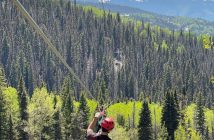The harnesses have been stored away, the helmets cleaned and stacked. Your lines and platforms are properly prepped for the cold, inactive winter season. Everything is in order so that you can hit the ground running next season. You’ve winterized your park, and you finally have a moment to breathe.
But did you properly winterize your staff?
Finding enough high-quality seasonal employees is among the most pressing concerns of adventure park operators. The processes of recruiting, training, managing, and keeping employees for the entire season become significant business challenges with high costs. And a solution to reduce the cost of these processes might have just walked out the door.
Stay in Touch
Maintaining strong relationships with the staff that just left can increase the return-rate of experienced, trained workers back to your park while reducing the recruitment and training costs associated with bringing in a completely new person. In order to accomplish this, build a strategy to engage this season’s seasonal staff during the off-season.
What does an engagement strategy for seasonal employees look like? First of all, you need a way to communicate with them. If you have permission, you can reach out to them via email, or you can simply call them. Also, you could create an employees-only page on Facebook, LinkedIn, or another social media platform. Whatever the channel, you will need to be sure that the messages are getting to the intended audience.
Next, you need to build a schedule for communicating. Spread your messages over the winter season so you remain atop the minds of your employees. Ultimately, you want them to strongly consider returning next year, and to remember that working for you was awesome.
What to communicate? Instead of a hard sell (e.g., “hey, we want you back!”), you might want to simply treat them as if they haven’t left. Keep the workplace experience going rather than treating it as a new recruitment effort. Here are some suggestions:
1) Share your successes and failures.
Employees want to know their work led to something. If you share the summer’s business highlights (revenue growth, customer satisfaction, injury rate decreases, etc.) employees can see that their efforts contributed to a positive outcome.
2) Ask for feedback.
We have all heard the adage, “people support what they help create.” Simply asking your seasonal workers the following three questions will help them feel included in the process of making the place even better: “What worked for you?” “What didn’t work for you?” and, “What would make this place even better?”
3) Tell them what you learned this year.
After receiving their feedback and doing your own reflection, share your “state of the park” address with your seasonal staff. Even if they don’t come back next year, this will demonstrate an important act of leadership. Sharing the surprises and key learnings with your team shows that you are open to improving yourself, and it sets an expectation that others should be open to it as well.
4) Tell them what will change next year.
As a leader, be sure to address feedback you receive. Tell them what will change. Let them know about course improvements, staffing structures, wage adjustments, new opportunities, capital investments, etc. If any changes are being made as a result of an employee suggestion, be sure to share credit. That sends a strong, team-oriented message.
5) Invite them back.
Sometimes all it takes is a well-timed invitation. You will increase your chances of attracting your best seasonal talent if you invite them back to something that’s worthy of their time and effort. Showing them that you’re on a path to making your park a great place for them to do their best work, and warmly inviting them to be part of it, will lead your best people to come back.
Your approach to keeping your employees connected will evolve over time. Whatever form it takes, maintaining this connection and treating staff like they never left mimics what the world’s best companies do: communicate regularly and transparently, welcome feedback, make adjustments based on what is learned, and create an environment where employees feel welcome.






